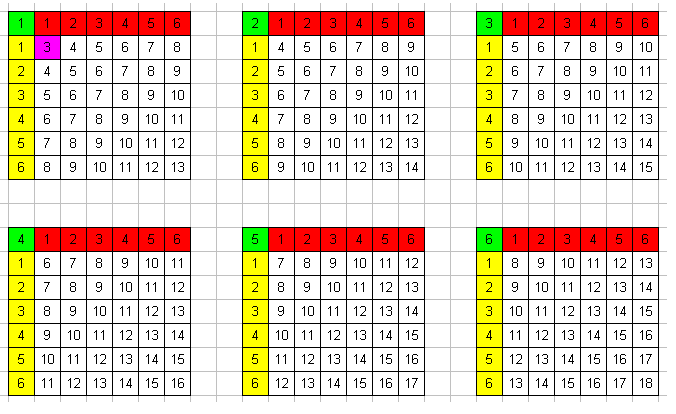Speed Math: 2D6 vs 3D6, when should I boost?
So my previous math rant had to do with getting masses of six-sided dice to do what you want. This is for a system more geared toward mass combat, like 40K. But for a more detailed skirmish based system like Warmachine, you need more complex statistics to figure out what you want to do.
In Warmachine, you roll 2D6 and add the result to an attack skill. If you meet or beat the enemy’s defense, you hit. But, if you roll the dice and every die you roll comes up “1” then you miss, even if the result would have been higher than the enemy defense. Look at this square I drew:
All you have to do is take the enemy defense, subtract your attack skill, and the result is the amount you have to roll to hit. Then, count up all the squares in the above picture and divide the result by 36 to get the percent chance to hit.
For example, a Cygnar Charger (RAT 6) is trying to shoot High Exemplar Kreoss (DEF 14). 14 – 6 = 8. So, the Cygnar player must roll an 8 or more to hit. You’ll see above that 15 of the squares are 8 or higher, so 15 / 36 = .416666 or 41.67% which is a little better than 2 in 5. Not very good odds.
Now imagine that the Charger had forgone his movement to gain a +2 aiming bonus (effective RAT 8). 14 – 8 = 6. Now there are 26 suares 6 or higher, so the chances are 26 / 36 = .722 or 72.2% better than seven in ten. Much more likely.
What if you NEED to hit Kreoss, but have to move to hit him? In Warmachine you can always boost to hit. This makes the math slightly harder, but it’s easy to break down visually. Click to zoom and actually see the numbers.

This would be easier in 3d but I don’t know how to do that, so I made 6 grids. This seems daunting at first, but once you see patterns you can go pretty fast. Now let’s say the Charger is boosting to hit. The check is the same (14 – 6 still equals 8 ) but now there is a 3D6 roll. You’ll notice in the first square that 21 of the 36 squares are 8 or more. In the second box, it’s 26 which is 21 + 5. In the third it’s 30 which is 26 + 4, one less than the previous increase. Then it’s 33 (30+3) 35 (33+2) and 36 (35+1). See the pattern?
So the total for all of these boxes 8 or more is 181. The total number of boxes is 216. 181 / 216 = .8397 or about 84%. Much higher than the 41.67% of the unboosted roll. It’s more than twice as likely now. However, you don’t ever really need to do the math on the 3D6 rolls ever. I just showed you so that you’d know that the 3D6 is much better than 2D6. Duh.
So when should you boost? Take a look at this handy dandy chart:

Common wisdom of Warmachine Forums says if you need a 6 or lower, don’t boost because in the end it’s a waste. According to the chart above, a 6 gives you a 72% chance. That’s pretty good. A 7 gives you a 58% chance, going from better than 7 in 10 to slightly worse than 6 in 10. Bu this can be modified if you NEED something to hit or if you don’t care, like if you’re taking a pot shot or swinging with an open fist when a Quake Hammer does the damage. So if you NEED the hit, an 83% chance might not even be safe enough and you’d boost needing a 5. However if you don’t care you might not boost even if you need a 10 which is a 1 in 6 chance. You’ll have to tailor it to the appropriate situation, but if you can call up that grid in your head and do some simple division, you can judge whether to boost or not pretty quickly. Probably faster than it takes for your opponent to look up the stats of his model.


Leave a Reply